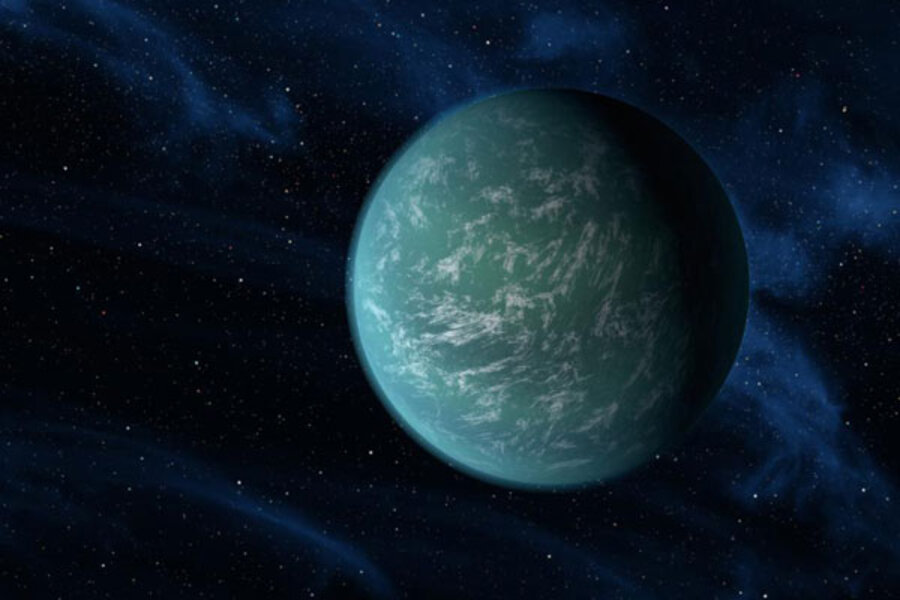Massive leap in search for habitable planets
Loading...
Researchers have found a way to tease information about an extrasolar planet's mass from an underappreciated source: its atmosphere.
The approach, described in a paper set to appear Friday in the journal Science, could help speed the pace at which scientists are able sort among planet-candidates to identify those potentially hospitable to, or even hosting, life.
"This is an exciting new result," says Mark Swain, a researcher at NASA's Jet Propulsion Laboratory in Pasadena, Calif., who studies exoplanet atmospheres.
It's particularly significant for planets orbiting red, small, dim stars known red dwarfs, he says. Other methods of trying to gauge the mass of a planet orbiting one of these stars "presently don't work very well."
Mass is crucial for estimating the bulk density of a planet – rocky, gaseous, predominantly water in some form, or a mix. If one is hunting for other Earths, the holy grail for planet hunters, it's not enough for a planet to orbit within a star's habitable zone, where in principle liquid water can pool and remain stable on a planet's surface. It's important to gauge its bulk composition as well.
Virtually all of the entries in the various rosters of planets beyond the solar system have mass estimates tied to them. But these estimates typically represent either a minimum or maximum mass, depending on the approach used to discover them. The radial velocity technique, which looks for the wobble in a star's spectrum an orbiting planet introduces, provides a minimum mass. The transit method, which looks for the shadow a planet casts as it passes in front of its host star, yields a maximum mass.
Ideally, researchers would like to make both types of measurements on the same planet, but often that's not possible. The new method could help improve the accuracy measurements for transiting planets.
As a planet passes in front of its sun, the star becomes a back light for the atmosphere. Scientists can detect what's called a transmission spectrum as elements and molecules in a planet's atmosphere absorb the light passing through the atmosphere at specific wavelengths.
Scientists then use models to tweak various traits about the atmosphere – such as how temperature and pressure change with altitude as well as the average mass of the molecules in the atmosphere – until they find the best fit for the observed transmission spectrum.
Julien de Wit, a graduate student at the Massachusetts Institute of Technology in Cambridge, was developing one of these models when he realized "while writing the equations that there might be a way to get mass," he says.
At the time, he was designing a model that would incorporate the presence of biologically generated gases in the spectrum of an extrasolar planet's atmosphere, so he didn't give his work on mass much thought. But when he showed his calculations to Sara Seager, a planetary scientist at MIT, she immediately recognized the importance, he recalls.
It works because one of the features affecting the changes in an atmosphere's pressure with altitude is gravity. In his equations, de Wit recognized that gravity could be defined in terms of a planet's radius and mass, so he added that approach to his calculations.
Since the transit method yields a good estimate of an extrasolar planet's radius, that would be an untweakable component of the calculations. This left mass as an additional "knob" the model could adjust to help generate a best-fit spectrum. As a result, the mathematical approach de Witt and Dr. Seager devised now allows researchers to back a mass estimate out of the models, in addition to the other data of interest.
"Why nobody saw this before, I don't know," says Dr. Swain, who observes exoplanet atmospheres. "But it's a really good insight, and it's going to help us out a lot."
How well does it work? De Wit and Seager used the approach on an exoplanet 63 light-years away, HD 189733b, that has been measured with radial velocity techniques to estimate its mass. Radial velocity measurements put the planet's mass at 1.14 times Jupiter's, give or take 6 percent. The new approach delivered an estimate of 1.15 times Jupiter's mass.
They also calculate how the approach will perform with two highly anticipated space telescopes: NASA's James Web Space Telescope, which will be able to observe the atmospheres of transiting planets orbiting stars in the sun's neighborhood; and the Exoplanet Characterization Observatory, a mission under study by the European Space Agency. De Wit and Seager estimate that between the two, astronomers should be able to characterize the atmospheres and nail down the masses of Earth-size and super-Earth-size planets out to about 326 light-years from Earth.
Swain adds that the approach also may play well with NASA's Transiting Exoplanet Survey Satellite, slated for launch in 2017. TESS will be hunting for transiting planets around 500,000 of the nearest stars. These include 1,000 of the closest red dwarfs, which are so dim that some planets orbiting such stars in only four to six days would be in the habitable zone.








